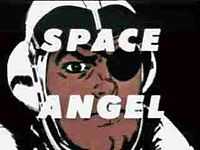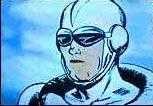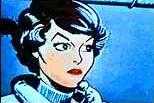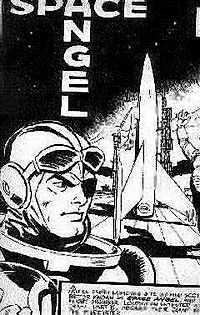Space Angel

Space Angel was an animated science fiction television series produced in the United States from early 1962 through 1964. It used the same Synchro-Vox lip technique as Clutch Cargo, the first cartoon produced by the same studio, Cambria Productions.
The series chronicled the adventures of three astronauts who worked for the Earth Bureau of Investigation's Interplanetary Space Force on board the spaceship Starduster: Captain/Pilot Scott McCloud, also known as "The Space Angel" (voiced by Ned Lefebver), Electronics/Communications expert Crystal Mace (voiced by Margaret Kerry), and the immensely strong Scottish born Gunner/Engineer Taurus (voiced by Hal Smith).
Setting and themes
The character name Space Angel was a secret identity. Scott McCloud had an eyepatch; when he appeared as Space Angel, he would lower bulging sunglasses from his helmet to cover it.
Apart from the use of Synchro-Vox, animation was very limited, but the static panel art by legend Alex Toth was often well-drawn. Story lines were serialized over five episodes which ran five minutes each, the idea being that stations could show one episode per weekday, with the climax coming on Friday. Cliffhangers were sometimes used, as in an episode with McCloud finding a derelict spacecraft beyond the light barrier, looking inside and exclaiming "Oh my God!" Another memorable sequence occurred with the heroes involved in a best two-of-three gladiator battle, using future visions of Roman combat.
There were several episodes involving space combat between the Interplanetary Space Force and various enemies. After the Space Angel and his crew had discovered the villains' plans or forces, he would call in reinforcements made up of one or more squadrons of the ISF. Squadrons were organized by planetary patrol areas such as the Venusian Squadron, Mars Squadron, etc. The identifying squadron symbols on the ISF ships were the ones used in astronomy charts of the time to identify the planets, such as the Female symbol for the Venusian Squadron, the Male symbol for the Mars Squadron and a circle with an enclosed plus sign for the Earth Squadron.
The main antagonists in the show were the Anthenians, who were modelled on a combination of Ancient Rome and Sparta; their home planet is shown in the episode involving the gladiatorial games. The city looks like Rome, including a colosseum. The civilians are dressed in togas and the soldiers are wearing a combination of Greek/Roman armor with Corinthian-style helmets. They are armed with blaster rifles.
Another antagonist is the Evil Queen of Space, who resembled Nefertiti, and her henchmen, "The General" and "The Major", who all spoke with Central European accents. Predating the Star Trek episode "Balance of Terror", their claim to fame is an invisible spaceship they use to disrupt interstellar trade.
In the opening sequence of "Space Hijackers (Solar Mirror)" a delta-winged spacecraft, The Starduster, docks with a space station. The ship matches velocity and rotation with the station and is talked in with instrument assist. This sequence foreshadows the space dock sequence of the delta-winged Orion from Stanley Kubrick's "2001: A Space Odyssey", which would be made seven years later.
The Starduster contains a smaller vessel, a space fighter flown by Space Angel, which looks like the XF-92 and is about the same size, though with a pointed nose. It is called the "Space Dart".
The theme music was written by Walter Greene and was originally used in Roger Corman's film "War of the Satellites" (1958).
Episodes



- Abominable Moon Men
- Big Bertha
- Crystal's Anti Boy Friend
- Power Failure
- Space Hijackers (Solar Mirror)
- The First Episode
- Project Hero
- The Frozen Planet
- Wizard of Eden
- The Plagued Plant
- The Donovan Plan
- The Plot
- Name Rank and Serial Number
- They Went That A'Way
- Scratch One Chimp
- Red Alert
- Incident of the Loud Planet
- The Day the Earth Went Dark
- Once Upon a Rainbow
- Welcome Neighbor
- Meets a Devil
- How to Win a Space Race Without Really Trying
- The Gold City Blues
- The Not So Mythical Beast
- Expedition to a New Moon
- Crisis in Orbit
- Gopher Broke
- Conflict Nova
- Cosmic Combat
- The Gladiators
- The Light Barrier
- The Slave World
- Dr. Kinkaid I Presume
- The Exiles
- The Saucer Caper
- Death of a Galaxy
- The Little People
- There Goes Danny
- The Visitor from Outer Space
- Rescue Mission
- Space War
- Dragon Fire
- Flight of Hotshots
- The Fugitives
- The Encoder
Space Angel in other media

Alex Toth drew Space Angel six page story for children's magazine Jack & Jill in 1963 to promote the Space Angel cartoon.
The episode "The Gladiators" was featured on Cinema Insomnia.[1]
In July, 2008, VCI Entertainment released a DVD that contained nine episodes of Space Angel.[2][3]
References
- ↑ "Cinema Insomnia: Prince of Space". Google Video. Retrieved 21 October 2010.
- ↑ Lambert, David. "VCI's Space Angel - Collection 1: Box Art, Details and Extras; Available in your galaxy on July 29th". TVShowsOnDVD.com. Retrieved 2008-06-19.
- ↑ "Space Angel Collection 1 (Full Col Dol) (1962)". Amazon.com. Retrieved 2009-04-18.
External links
- Space Angel at Toon Tracker
- Space Angel at Toonopedia
- Space Angel at Cartoon-O-Rama
- Space Angel at the Internet Movie Database
- Space Angel at TV.com